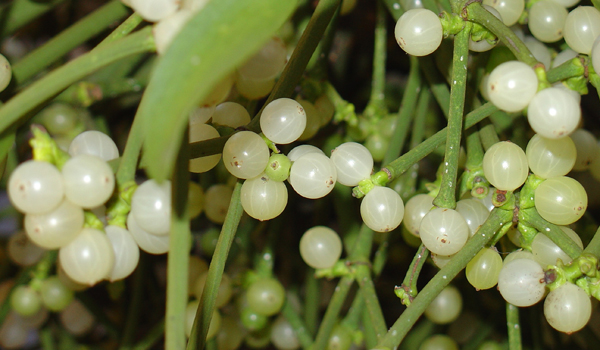Pucker Up! Why Do People Kiss Under the Mistletoe?

Mistletoe is one of the many Christmas holiday traditions that, frankly, most people do not understand but play along with anyway. But mistletoe's magical hold over holiday lovers goes back way before the first office Christmas party.
There are hundreds of species of mistletoe a parasitic green plant that grows on trees and shrubs that can be found around the world, and as such, many cultures have worked the plant into their customs and mythology. Many ancient groups associated mistletoe with fertility and vivacity, and some considered it an aphrodisiac.
[Got a question? Send us an email and we'll look for an expert who can crack it.]
The Celtic Druids are among the first people known to ascribe a tradition to mistletoe, using it in ceremonies at least a few thousand years ago, but they didn't kiss under it. They believed mistletoe, especially a rare species that grew on oak trees, to have sacred powers including the ability to heal illnesses, protect against nightmares, and even predict the future. As such, the Druids would collect it during the summer and winter solstices hence, they were most likely the first to use mistletoe to decorate houses around Christmastime, although their tradition had nothing to do with the Christian holiday.
The tradition of kissing under the mistletoe started in ancient Greece, during the festival of Saturnalia and later in marriage ceremonies, because of the plant's association with fertility. During the Roman era, enemies at war would reconcile their differences under the mistletoe, which to them represented peace. Romans also decorated their houses and temples with mistletoe in midwinter to please their gods.
There is also a Nordic myth concerning mistletoe, and it goes like this: The plant was sacred to Frigga, the goddess of love, but Loki, commonly known as the god of mischief, shot Frigga's son with a spear or, in some tellings, an arrow carved from mistletoe. Frigga revived her son under the mistletoe tree and decreed that anyone who stands under the mistletoe tree deserves not only protection from death, but also a kiss.
In Victorian England, kissing under the mistletoe was serious business. If a girl refused a kiss, she shouldn't expect any marriage proposals for at least the next year, and many people would snub their noses at her, remarking that she would most likely end up an old maid.
Get the world’s most fascinating discoveries delivered straight to your inbox.
Today, we take a much more lighthearted approach to the tradition. Although many couples simply just kiss when caught standing under it, there is actually a proper etiquette dating back to ancient times about kissing under the mistletoe. Linda Allen writes in Decking the Halls: The Folklore and Traditions of Christmas Plants that the gentleman should pluck one white berry while kissing the lady on the cheek. One kiss is allowed for each berry.
It should be mentioned, however, that the plant contains toxic amines , and eating its berries can cause vomiting and stomach pain. In the past, mistletoe had been thought to be a cure for epilepsy and other ailments, but was proved false. In fact, mistletoe is probably more harmful than helpful: deaths have even been reported from drinking too much tea made from its berries.
So let's just stick to kissing under it.
